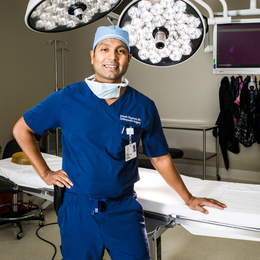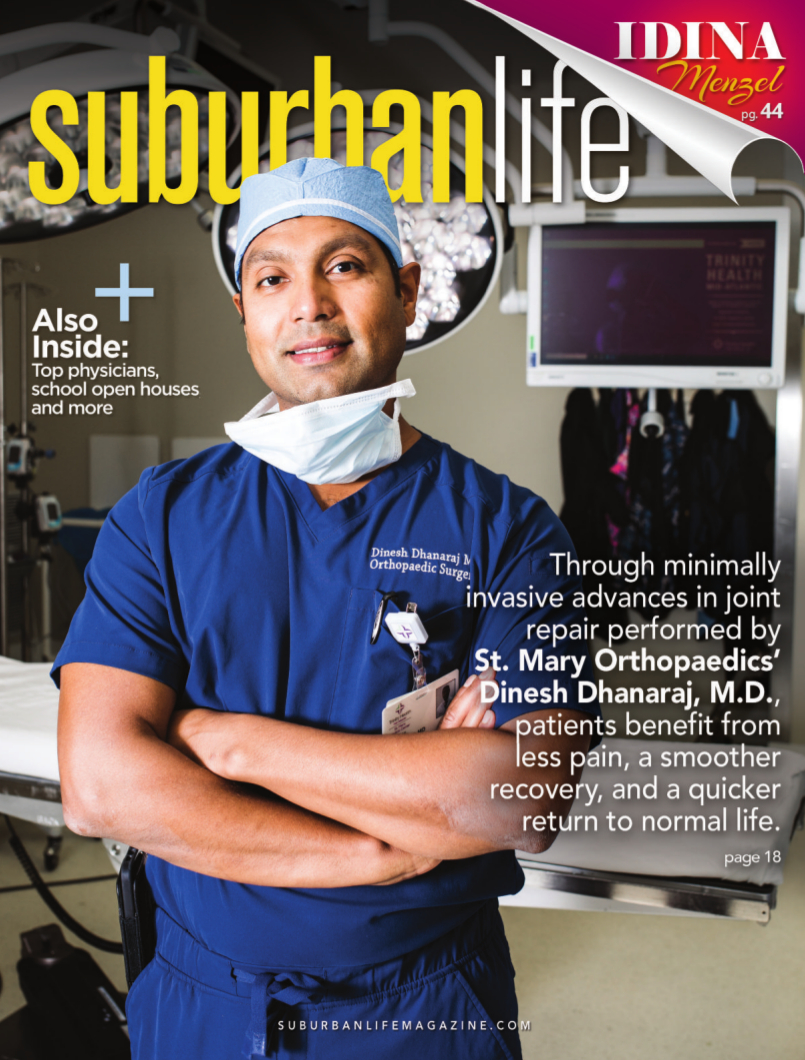
Returning to Form
Through minimally invasive advances in joint repair, St. Mary Orthopaedics patients benefit from less pain, a smoother recovery, and a quicker return to normal life.
Pat Riesterer will always remember the day after Thanksgiving 2020 for a reason she would rather forget.
As Riesterer was moving a mattress and box spring in a spare bedroom, she fell and landed on the metal bedframe. She blacked out from the pain, which she recalls as “worse than having a baby.” When she came to, she told her husband, who had been mowing the lawn, that she likely broke her arm. An ensuing trip to urgent care revealed a dislocated shoulder. She was promptly referred to a nearby hospital where she could get patched up.
In the days and weeks to follow, however, it became apparent that the injury was worse than initially suspected. She paid a visit to a trusted orthopedic surgeon with St. Mary Orthopaedics in Langhorne who had fixed a torn rotator cuff for her 20 years earlier. The verdict: another torn rotator cuff. Before recommending surgical intervention, the surgeon first wanted to see if conservative therapies would improve the injury. The conservative approach did not yield dividends, however, so the surgeon then referred her to a St. Mary colleague: Dinesh Dhanaraj, M.D., M.S.P.H.
“That’s when they said SCR,” recalls Riesterer, now 73. “Dr. Dhanaraj gave me a few different options, but he said SCR was the best option considering my age and the severity of the tear.”
By “SCR,” she’s referring to a procedure called arthroscopic superior capsular reconstruction, developed specifically for patients with significant rotator cuff tears. During this minimally invasive outpatient procedure, the tendons are debrided (cleaned, with the dead tissue removed) and anchored to the bone using a dermal allograft, or a skin graft from a tissue donor, to patch and repair the rotator cuff capsule. In most cases, patients experience restored shoulder function within three months.
Dr. Dhanaraj performed the surgery on Riesterer in late June. She has since recovered the full use of her arm and shoulder. During a recent physical therapy session, in fact, her therapist gave her a telling compliment: “I’m amazed. Most people seven weeks out [from surgery] don’t have the mobility you have.”
As Riesterer’s experience suggests, St. Mary Orthopaedics has made remarkable advancements in sports medicine and joint repair for patients whose knees, hips, and shoulders have begun to wear out due to injury or repetitive use. Previously, major surgery was often considered the only option.
“In general, the advancements have led us to get patients and athletes back on the field faster,” says Dr. Dhanaraj. “With typical injuries to knees in the past, I’d repair them, brace them, and immobilize them for several weeks. I’d put the patient on crutches. The process was long. Today, with more minimally invasive techniques, there’s less pain and faster recovery. Now, they’re in a brace for only 10 to 14 days, and we’re getting them back moving again and exercising much sooner.”
At St. Mary Orthopaedics, Dr. Dhanaraj is among a team of board-certified orthopedic surgeons, nurses, licensed physical and occupational therapists, and orthopedic nurse navigators pledged to provide patients with the continuum of care. Their shared goal: to put patients on the fast track to a complete recovery.
Advances such as SCR and cartilage regeneration offer appealing alternatives to joint replacement. Dr. Dhanaraj references MACI, shorthand for matrix-induced autologous chondrocyte implantation. MACI uses cartilage-forming cells from the patient’s own body to restore damaged cartilage in the knee. The surgical procedure involves a biopsy to harvest cartilage-forming cells, or chondrocytes, which are allowed to multiply in a lab for four to six weeks. The new cells are then implanted into the damaged joint to regenerate with the surrounding cartilage, which provides a cushion between bone endings.
“Cartilage regeneration is such an interesting and effective process that we do,” says Dr. Dhanaraj. “Once cartilage wears out in the body, it doesn’t regenerate on its own. That causes the bones of the joint to run against each other, causing pain. Now, we can take cartilage cells by going into the knee with a small camera and shaving off a piece—as small as a Tic Tac—from a non-weight-bearing portion of the knee. The cells are processed and sent to a lab in Boston, where they are multiplied and implanted on a membrane made of collagen. When I get them back, I implant the membrane back into the knee through a mini-opening I make.”
Dr. Dhanaraj suggests the patient is instructed to be on crutches for about six weeks. While someone might need up to nine months before being cleared to resume playing sports or other activities, the knee will be healthier for the rest of their life.
“It’s like something out of science fiction,” he says. “When a patient suffers a knee injury, hears that pop, feels that pain, it seems like the end of the world to them. But when I tell them what I can do to fix it, and that we’ll get through this together, that they’ll be fine, it tends to calm them. It becomes very reassuring to them.”
Dr. Dhanaraj graduated from the University of California, Berkeley’s Molecular and Cell Biology program, with an emphasis in cellular developmental biology. He also holds a master’s degree in public health from Tulane University’s School of Public Health and Tropical Medicine. He obtained his medical degree from the University of Texas Health Science Center in San Antonio. He completed his surgical internship and orthopaedic surgery residency at the New York University Hospital for Joint Diseases in New York City. While there, he gained experience working with athletes from the high school to collegiate level in sports, from professional ballet to professional hockey. In addition, he trained at Manhattan’s famed Bellevue Hospital and other Level-I trauma centers throughout New York City.
Dr. Dhanaraj also completed an orthopaedic sports medicine fellowship at The Hospital of the University of Pennsylvania. This fellowship, combined with experience working with The Children’s Hospital of Philadelphia, allowed Dr. Dhanaraj to become skilled at arthroscopic techniques in both adults and children. Apart from his surgical skills, he believes his own medical history is of great comfort to patients; as a collegiate judo practitioner, he sustained many sports injuries, including fractures, a herniated disc, and even nerve damage in the spine.
“I put them at ease, I believe, because they realize I know what they’re going through,” he says. “When we get through it together, when I’m able to do a procedure that helps a patient get back to what they love to do without pain, the look of relief and thanks I get from them is priceless. There is no better feeling as a doctor than seeing that.”
Pat Riesterer is among those patients. In early August, she did something most of her family would have thought impossible considering the injury she suffered less than a year earlier: She cooked and hosted a late-summer Thanksgiving feast for her family at her Bucks County home.
“My family was amazed that I was able to make the whole dinner, including a full turkey,” she says. “They couldn’t believe it. Dr. Dhanaraj made me whole again, and that takes a lot. He was fantastic, and I would recommend him to anyone who needs this surgery. I love that man.”
For more information about St. Mary Orthopaedics, call (267) 364-9100 or visit www.trinityhealthma.org/orthopedics.
Photography by Gabriela Barrantes
Published (and copyrighted) in Suburban Life magazine, August 2021.



